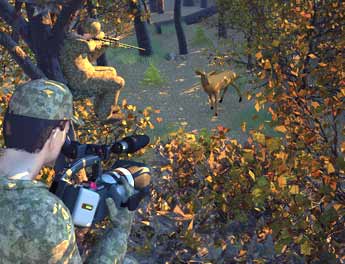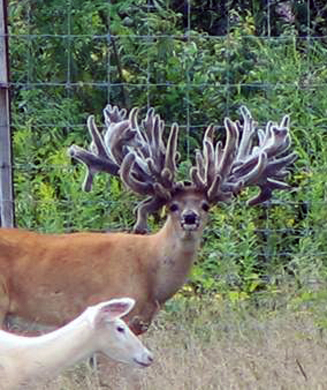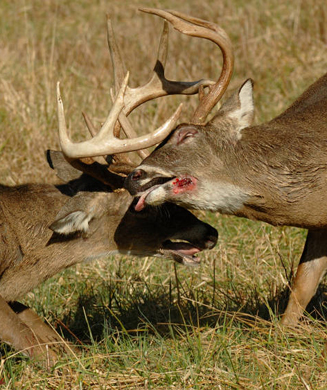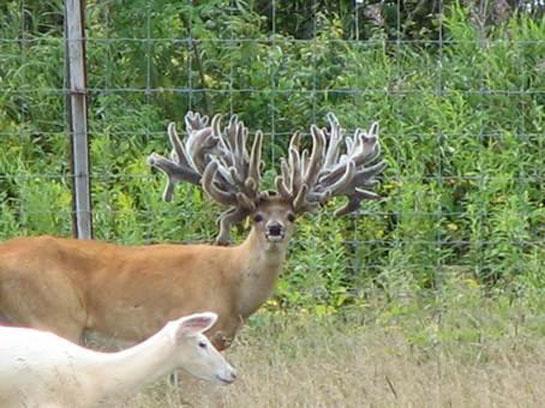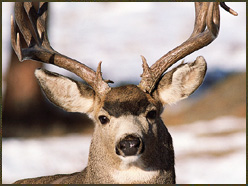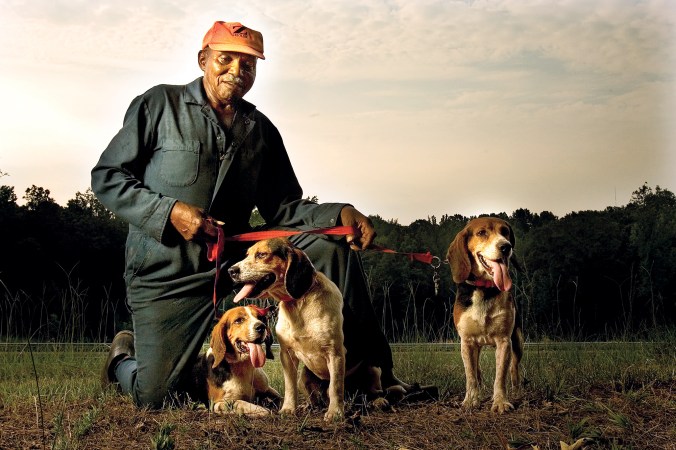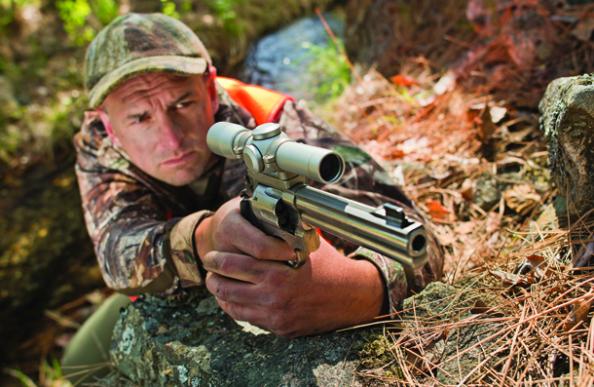The hunt is on, boasts the pithy marketing mantra of the World Hunting Association (WHA). In June the fledgling venture unveiled a competitive circuit so ambitious that its founder, David Farbman, describes it as “God’s vision.”
That statement is one reason why Farbman, a 34-year-old real-estate executive from Southfield, Mich., will never be accused of lacking conviction in what has immediately become a contentious issue: Does hunting and tranquilizing large deer in an enclosed environment qualify as a sport? More to the point: Will a competition like this be a good thing for hunting?
Listen to the outrage the plans have sparked and you’ll wonder if people, rather than whitetails, should be injected with the tranquilizing agent the WHA intends to use to sedate deer. The tranquilizer, incidentally, will be administered by a dart fired from a rifle using a .22 rimfire blank in the hands of a debatably named “professional hunter.” The woozy whitetail’s antler mass will subsequently be measured and scored. Of the four deer a hunter can take during the first round of the tournament, only two can be taken with the rifle. The other two must be taken by bow, using compound bows with arrow speeds of up to 200 feet per second.
The inaugural event is scheduled to take place in October at Lost Arrow Ranch, a 1,000-acre, high-fenced tract of northern Michigan forest, scrub and swamp. There, eight two-person teams (consisting of a hunter and a cameraman) will vie for up to $300,000 in prize money. A second event is slated for Lost Arrow in November, if all goes according to plan. Between the two events a total of $500,000 in prizes is on the line.
[pagebreak] Catch-and-Release Deer
Farbman’s dream is to establish the WHA as a professional sport for hunters in the model of the bass circuit. Its ultimate mission is to reverse hunting’s dwindling participatory numbers by drawing younger people, women and nonhunters into a sport that, in Farbman’s view, is waiting to be understood and appreciated.
His idea began taking shape early in 2005 and is financed by a group of anonymous investors, as well as Farbman himself. What the WHA wants to do is to bring hunting’s allure to a broad audience through the use of 21st-century chemical and electronic technology.
In what it perceives as a parallel to the pro bass tour, the WHA will employ catch-and-release-thus, the tranquilizer darts. Everything about the competition is the highest of high tech: Global positioning systems will track deer and hunters, providing laptop monitoring for the WHA’s targeted youth audience. Web cams will deliver a reality-TV element as they show deer moving into a specific area, theoretically creating suspense for viewers who will see deer and hunters before they see each other.
There are pay-per-view and on demand ideas and some early feelers from a cable network (“Has anyone called from TV?” Farbman asks himself for my benefit. “Yes, they have, but I don’t care to talk about that yet.”).
Farbman’s hunters will be marketed like pro wrestlers. Brett “The Dark Archer” Hankins, scent-specialist Karl “The Doctor” Zanitzer and Joey Menegatti (“The Cowboy”) are three of a projected eight-man WHA roster of competitors. Farbman sees the hunters as colorful celebrities awaiting their individual cult followings.
And, oh yes, there will be original music, as well as beautiful “WHA ladies” to spice up the scenery.
“They’ll offer tips and strategies, and maybe a little opinion on issues,” Farbman says, with a knowing grin. “We’ve recruited them. They’re intelligent, they have energy, they understand hunting. And they’re good on camera as well.”
This is fortunate, given that critics think the hunting will be bad for viewers, and even worse for hunting’s image.
[pagebreak] The Backlash
Within minutes the WHA’s June announcement, Internet chat rooms and blogs flooded with invective (some would say paranoia) aimed at the WHA’s bold notion.
“They’re trying catch-and-release on an animal that was never meant for catch-and-release,” says Luke Strommen, 28, an archery guide from Vandalia, Mont., and a contributor to HuntingNet.com. “What Farbman is telling us by turning hunting into a competition is that he’s missing the whole reason for why we hunt-the sacredness of it. Drugging a deer, giving it an antidote, letting it stagger back…. It goes against everything that’s ethical and moral about hunting.”
Michael Hanback, an Outdoor Life contributing editor and blogger, has been among the WHA’s harshest critics.
“This whole thing is so far from the spirit of hunting, and what hunting means on an emotional level, that it offends true hunters,” Hanback says. “I keep coming back to the root of hunting, and I don’t see where it’s a fit.”
Strommen’s ire and Hanback’s woe mesh neatly with indignation from organizations such as the U.S. Sportsmen’s Alliance, which considers the WHA about as reflective of hunting as a bullfight.
Rick Story, a USSA senior vice president, finds most aspects of the WHA offensive, none more than its plans to use a tranquilizing cocktail (Xylazine and Telazol, standard agents for sedating deer) as the means by which whitetails are to be incapacitated and scored in WHA events.
“Shooting an animal for a contest with these things does not fall into the realm of research, pathology or treatment,” Story says. “They’re basically using these drugs for fun.”
Sticking a deer with a barbed, 6-inch projectile loaded with Xylazine and Telazol is for most WHA critics enough reason to brand Farbman’s project as unredeemable. Throw in the fact that tranquilizing a game animal, in any state, is illegal outside of a controlled environment, and you quickly have a second disqualifier for most who oppose the WHA.
Brian Murphy, a wildlife biologist and now executive director of the Quality Deer Management Association in Bogart, Ga., met with Farbman in July. Their meeting did not dissuade Murphy from his early skepticism.
“There’s no legal opportunity to do this (tranquilizing) in the wild,” Murphy says. “I can’t go out on my own to dart deer. It takes oversight and protocol that won’t be given for this kind of rodeo.
“The deer are also confined to pen operations, and we all know the stigma associated with that. My third point is, I don’t believe our noble game animal deserves to be placed in a target environment for a contest. Hunting is a very individual, a very spiritual, activity. Deer deserve better.”
Murphy is also concerned, as are most WHA critics, about mortality rates they say will certainly exceed the 2 percent ceiling cited by Farbman and his associates.
“I’ve darted several hundred deer and there’s a risk of mortality with any technique, and with the one Farbman is using-Xylazine and Telazol-there’s a five to ten percent chance,” Murphy says. “Some of these deer will be overmedicated, some undermedicated. Some will die several days later.”
Farbman and Chuck Sykes, a biologist who has consulted with the WHA founder regarding habitat and game management, boil at such assertions. Farbman says false notions about the WHA’s careful methodology for protecting tranquilized deer are at the heart of a furor they view as baseless.
On-site veterinarians will oversee hunters and the delivery system for their tranquilizing agent. Tranquilized deer, they assure, will be given a veterinarian-supervised “reversing agent” (Tolazoline) and will be monitored by those same doctors for 24 hours or more.
Farbman and Sykes, who at press time was in negotiations with the WHA to serve as its chief biologist, stick by their guarantee of no more than a 2 percent mortality risk. “To think we’ll never have a mortality is not a fair assumption,” Farbman says.
They also say no deer will be shot more than once in a single tournament, or more than twice in a tournament year. Such animals, they insist, will be clearly marked.
“Anything new and novel is going to draw criticism,” says Sykes, who lives in Wetumpka, Ala., where his deer-management television program, The Management Advantage, is based. “But in my opinion, a lot of people have been running their mouths before they get all the facts. Once everything is out there, I think they’re going to change their minds.”
The Xylazine-Telazol combo “is a conventional cocktail that has been used and tried, and is proven,” says Sykes, who holds a wildlife biology degree from Auburn University. “There are going to be some fatalities-it’s going to happen any time you’re taking deer, whether it’s by helicopter drop nets or handling deer in pens with drugs. But with the precautions we’re taking, the drug selection, everything that goes into it, the losses are going to be minuscule.”
Even for those who can look past this issue, the thought of hunting deer within an enclosure-1,000 acres of rough-and-tumble terrain notwithstanding-is for many a taboo.
“I don’t agree with pens,” Strommen says. “I don’t care if it’s a thousand acres or a million acres. A pen is a pen.”
[pagebreak] Hunting’s Savior?
Farbman believes there is more than a little hypocrisy among critics who see no problem in tournament fishing for bass, or in accepting a single-digit mortality rate for fish. He chuckles at hunters who say they cannot abide the “competitive” notion he’s bringing to hunting when, he says, Boone and Crockett and Pope and Young-to say nothing of deer-camp contests for the biggest rack-are part of North America’s hunting culture.
Not surprisingly, neither Boone and Crockett nor Pope and Young view themselves and their record keeping efforts as embodiments of “competitive” hunting. “The Boone and Crockett records book is not a contest among hunters. It is a celebration of the success of our conservation system,” says Keith Balfourd, a spokesman for Boone and Crockett.
But Farbman is exasperated that his critics do not see him and this effort for what he believes it is: a conduit bringing to North America all that is sublime, even divine, about hunting. If this venture succeeds on the scale he envisions, there will be a WHA foundation devoted to dispensing half of all proceeds to organizations aimed at steering the public, youth particularly, to a sport Farbman regards as sacred.
“I think you’re going to see real changes in the way the world will look at hunting,” says Farbman, who imagines hunting trips for kids, women and the physically challenged. “Are we here to make a profit?” he asks. “Yes-shoot me. But that’s not the objective. This is to build the whole industry and to raise the ibman says.
They also say no deer will be shot more than once in a single tournament, or more than twice in a tournament year. Such animals, they insist, will be clearly marked.
“Anything new and novel is going to draw criticism,” says Sykes, who lives in Wetumpka, Ala., where his deer-management television program, The Management Advantage, is based. “But in my opinion, a lot of people have been running their mouths before they get all the facts. Once everything is out there, I think they’re going to change their minds.”
The Xylazine-Telazol combo “is a conventional cocktail that has been used and tried, and is proven,” says Sykes, who holds a wildlife biology degree from Auburn University. “There are going to be some fatalities-it’s going to happen any time you’re taking deer, whether it’s by helicopter drop nets or handling deer in pens with drugs. But with the precautions we’re taking, the drug selection, everything that goes into it, the losses are going to be minuscule.”
Even for those who can look past this issue, the thought of hunting deer within an enclosure-1,000 acres of rough-and-tumble terrain notwithstanding-is for many a taboo.
“I don’t agree with pens,” Strommen says. “I don’t care if it’s a thousand acres or a million acres. A pen is a pen.”
[pagebreak] Hunting’s Savior?
Farbman believes there is more than a little hypocrisy among critics who see no problem in tournament fishing for bass, or in accepting a single-digit mortality rate for fish. He chuckles at hunters who say they cannot abide the “competitive” notion he’s bringing to hunting when, he says, Boone and Crockett and Pope and Young-to say nothing of deer-camp contests for the biggest rack-are part of North America’s hunting culture.
Not surprisingly, neither Boone and Crockett nor Pope and Young view themselves and their record keeping efforts as embodiments of “competitive” hunting. “The Boone and Crockett records book is not a contest among hunters. It is a celebration of the success of our conservation system,” says Keith Balfourd, a spokesman for Boone and Crockett.
But Farbman is exasperated that his critics do not see him and this effort for what he believes it is: a conduit bringing to North America all that is sublime, even divine, about hunting. If this venture succeeds on the scale he envisions, there will be a WHA foundation devoted to dispensing half of all proceeds to organizations aimed at steering the public, youth particularly, to a sport Farbman regards as sacred.
“I think you’re going to see real changes in the way the world will look at hunting,” says Farbman, who imagines hunting trips for kids, women and the physically challenged. “Are we here to make a profit?” he asks. “Yes-shoot me. But that’s not the objective. This is to build the whole industry and to raise the i
